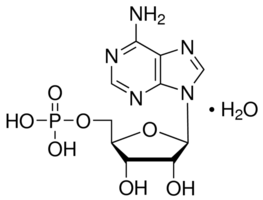
 Identification
Properties
Safety Data
Specifications and Other Information
Links
Identification
Properties
Safety Data
Specifications and Other Information
Links
Identification
CAS Number
61-19-8
Name
Adenosine 5′-monophosphate
Synonyms
Adenosine monophosphate [Wiki] [(
2R,
3S,
4R,
5R)-5-(6-Amino-9H-purin-9-yl)-3,4-dihydroxytetrahydro-2-furanyl]methyl dihydrogen phosphate 200-500-0 [
EINECS] 5′-Adenylic acid [
ACD/Index Name] [
ACD/
IUPAC Name] 5′-AMP 9-(5-O-Phosphono-β-D-ribofuranosyl)-9H-purin-6-amin [German] a-5mp acide 5′-adenylique [French] Adenosin5′-(dihydrogenphosphat) [German] [
ACD/
IUPAC Name] adenosine 5′-monophosphate Adenosine 5′-monophosphate Adenosine 5′-phosphoric acid adenosine phosphate [
BAN] [
INN] [
USAN] Adénosine-5′-(dihydrogène phosphate) [French] [
ACD/
IUPAC Name] adenosine-5′-monophosphate Adenosine-5′-monophosphate
ADENOSINE-5′-MONOPHOSPHORIC
ACID Adenosine-5′-phosphoric Acid adenosini phosphas [Latin]
AMP fosfato de adenosina [Spanish] [
INN] t-Adenylic Acid 5′-adenylate Adenosine 5′-phosphorate Adenosine-5′-monophosphorate Adenosine-5-monophosphorate Muscle adenylate (S)-1-C-(7-Amino-1H-pyrazolo(4,3-d)pyrimidin-3-yl)-1,4-anhydro-D-ribitol, 5-(dihydrogen phosphate) [(
2R,
3S,
4R,
5R)-5-(6-aminopurin-9-yl)-3,4-dihydroxyoxolan-2-yl]methoxyphosphonic acid [(
2R,
3S,
4R,
5R)-5-(6-aminopurin-9-yl)-3,4-dihydroxyoxolan-2-yl]methyl dihydrogen phosphate [(
3S,
2R,
4R,
5R)-5-(6-aminopurin-9-yl)-3,4-dihydroxyoxolan-2-yl]methyl dihydrogen phosphate {[(
2R,
3S,
4R,
5R)-5-(6-amino-9H-purin-9-yl)-3,4-dihydroxyoxolan-2-yl]methoxy}phosphonic acid 124-68-5 [
RN] 24937-83-5 [
RN] 5?-Adenylic Acid 5′-Adenylic acid 54612 [Beilstein] 5′-Adenosine monophosphate 5′-Adenylic acid, 8-amino- 5′-AMP
“14,158” 12352005 5′-O-phosphonoadenosine 61-19-8 [
RN] 9H-purin-6-amine, 9-(5-O-phosphono-β-D-ribofuranosyl)-
A5MP A-5′-P Adenosin-5-monophosphate
ADENOSINE 3′(+2′)-MONOPHOSPHORIC
ACID MONOHYDRATE BIOCHEMIKA 96% Adenosine 5′-monophosphate adenosine 5′-(dihydrogen phosphate) adenosine 5’-monophosphate adenosine 5′-phosphate Adenosine 5-Monophosphate Adenosine 5′-monophosphoric acid
ADENOSINE 5′-PHOSPHATE adenosine 5prime-monophosphate Adenosine, mono(dihydrogen phosphate) (ester) adenosine-5′-phosphate adenosine5′-monophosphate Adenosine-5-monophosphoric acid adenosine-5’P Adenosine-5-phosphate
ADENOSINE-5′-PHOSPHATE adenosine-monophosphate adenosine-phosphate Adenovite Adenyl Adenylate Adenylic acid Adenylic acid (
VAN) Ado5’P
AHI AMP (nucleotide)
AMP (
VAN)
ANP ASMP ATS Cardiomone
DESCARBOXY-NOR-N(ω)-HYDROXY-L-ARGININE Ergadenylic acid Formycin 5′-phosphate Lycedan
MFCD00005750 [
MDL number]
MFCD00149360 [
MDL number] Monophosphadenine Muscle adenylic acid Muskeladenosin-phosphorsaeure Muskeladenylsaeure My-B-Den My-B-Den (trade name) Myoston
OR-3757 P5P pA PAdo Phosaden Phosphaden phosphate d’adenosine [French] [
INN] Phosphentaside Phosphoric acid mono-[(
2R,
3S,
4R,
5R)-5-(6-amino-purin-9-yl)-3,4-dihydroxy-tetrahydro-furan-2-ylmethyl] ester Purine Riboside-5′-Monophosphate Vitamin
B8 Molecular Structure

structure of Adenosine 5′-monophosphate CAS 61-19-8
SMILES
c1nc(c2c(n1)n(cn2)[C@H]3[C@@H]([C@@H]([C@H](
O3)
COP(=O)(O)O)O)O)N
StdInChI
InChI=
1S/
C10H14N5O7P/c11-8-5-9(13-2-12-8)15(3-14-5)10-7(17)6(16)4(22-10)1-21-23(18,19)20/h2-4,6-7,10,16-17H,
1H2,(
H2,11,12,13)(
H2,18,19,20)/t4-,6-,7-,10-/m1/s1
StdInChIKey
UDMBCSSLTHHNCD-KQYNXXCUSA-N Molecular Formula
C10H14N5O7P Molecular Weight
347.22
EINECS
200-500-0
Beilstein Registry Number
54612
MDL Number
MFCD00149360 Properties
Appearance
White to off-White powder or crystalline powder
Safety Data
WGK Germany
3
Specifications and Other Information of Our Adenosine 5′-monophosphate CAS 61-19-8
Standard
Enterprise standard
Identification Methods
HPLC Purity
98% min
pH
2.5-3.5
Transmissivity of solution
≥97%
Arsenic
≤0.00015%
Contents
≥98%
Heavy Metals
≤0.001%
Loss on Drying
6.0% max
Storage
Preserve in tight containers,in a cool and dry place
Application
1. This product is Clinically used for disseminated sclerosis, porphyria, itching, liver disease, varicose ulcer complications. The eye drops containing mainly
AMP can be used for the corneal surface diseases of asthenopia,central retinitis, pannus and herpes. 2. This product can be used as nutrition enhancer. It can be added to the milk to increase the amount of nucleotides ,make them closer to human milk ingredients ,so as to enhance infant’s resistance against bacterial diseases. 3. This product can be used as biochemical reagent and intermediate for the production nucleotide drugs. And it can be used for the production of Vidarabine,
ATP,cAMP, coenzyme A, coenzyme I, etc..
Links
This product is developed by our RandD company Ulcho Biochemical Ltd(
http://www.ulcho.com/), and here is the corresponding link
http://ulcho.com/adenosine-5-monophosphate-cas-61-19-8/
Quick Inquiry
Fill out our inquiry form and one of our experts will be in touch with you shortly (Please change screen to horizontal for complete browsing if you are checking Watson on your mobile phone).
andD purpose. It may be toxic or hazardous, and should be handled only by qualified individuals trained in laboratory procedures. The buyer will be responsible to warn and inform any person that may be in contact with the product of the potential risks and hazards, as well as to ensure that purchase, use and disposal of the product comply with local laws and regulations.

 Identification
Properties
Safety Data
Specifications and Other Information
Links
Identification
Properties
Safety Data
Specifications and Other Information
Links

 Identification
Properties
Safety Data
Specifications and Other Information
Links
Identification
Properties
Safety Data
Specifications and Other Information
Links